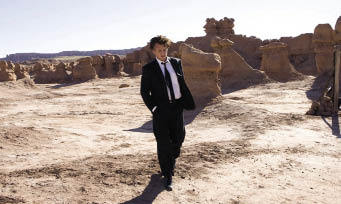Terrence Malick’s The Tree of Life is his fifth film in 38 years (what a lazybones!) and travels way beyond what I can think about, or any of us can think about, which may be its point.
Terrence Malick’s The Tree of Life is his fifth film in 38 years (what a lazybones!) and travels way beyond what I can think about, or any of us can think about, which may be its point. How are we here? Why are we here? In what way do the ‘how’ and the ‘why’ connect, if they do? I know. Exhausting. And although people say you should not watch a Malick film as you do other films, that you should immerse yourself in it as if it were a meditative experience, I simply don’t know how you are meant to accomplish this. Are there evening classes? Self-help books? But — and this is a big ‘but’, so pay attention — even though you have to work so devilishly hard at this, and work at it while Malick is probably still in bed (such a lazybones!), and even though it is grandiose and humourless and preposterous it is also fantastically fresh, rich and fascinating.
Let’s put it another way: two and a half hours of Terrence Malick goes by a lot quicker than 90 minutes of Larry Crowne, and I understood every word and frame of that. (Ditto Transformers 3 and Kung Fu Panda 2 and all the other interminable rubbish I have to sit through while checking my watch hasn’t actually stopped, and cursing the day I was born.)
This film is fragmentary and not linear — wouldn’t you be more surprised if it were? — and is partly a visual essay on the evolution of the universe (yes, really), partly a coming-of-age story, and partly a study of nature which, I think, gives us enough to be getting on with. You want more? OK, it’s also a philosophical contemplation on religion. Happy now?
It all ripples out from Jack O’Brien (Sean Penn), an architect living amidst concrete edifices and skyscrapers and who is divorced, I suppose, from all things natural, or at least that’s the way it seems. (How do you stop a mind straining to join the dots? How?) Jack is looking back to his childhood in 1950s Texas; a childhood spent with his two younger brothers, his father (Brad Pitt) and his mother (Jessica Chastain, so beautiful it’s as if she’s from another world). Mr O’Brien has his gentle, loving moments, but is also a stern disciplinarian given to bouts of violence, cruelty and bullying. Mrs O’Brien, while frustratingly passive, is also angelic, perhaps even saintly. The voiceover provided by the characters, often whisperingly, suggest he is nature (aggression) and she is grace (acceptance) or, maybe, that he is God, kind of, and she is Madonna (Jesus’s mom, not the singer; don’t be silly). The family is seen though the eyes of the young Jack (Hunter McCracken), who struggles between the two forces his parents embody.
Much is not explained. Why does the youngest brother have a scarred scalp? We know the other brother dies at 19, but how? The family are Catholic and when a local boy drowns in a swimming hole and Jack asks, ‘Lord, where were You? Why? Who are we to You?’ does this film provide an answer somewhere? Am I looking in the right place? Is it like Where’s Wally? I don’t know. I can only say it exerts a terrific hold.
There is no real plot as such and, at one point, Malick completely abandons the O’Briens for a 20-minute, CGI segment about the origins of the Earth, involving cosmic explosions, vast interstellar conflagrations, planets forming, primordial swamps, the first cells of life, hammerhead sharks and even dinosaurs lounging by a river. (Apparently, Malick practised for the dinosaur scene by dressing lizards up in little dinosaur costumes; now that has to be worth getting out of bed for.) Luckily, I don’t have anything to say about this segment except that it is supremely beautiful, just as so much of this film is.
Malick’s camera movements take you through windows and float you up high in unexpected ways. The cinematography is spectacularly lush, with scenes that mesh waterfalls with baby’s feet, and church windows with long grass swaying in the breeze. ‘Malick has never met a tree he doesn’t like,’ I overheard one critic say on the way into the screening, and this is true. However, to be a full-on, Malickian tree, it should have sunlight filtering down through it, or beads of rain collecting on its leaves.
Ideally, you would bathe in a film like this without striving to decipher it. As it’s a film about what we can’t get our heads around, we are probably not meant to get our heads round it. But, even so, it is so audacious it will take your breath away. I’m still waiting for mine to return.
(PS: It may also be about loss of innocence, just so you know.)






Comments